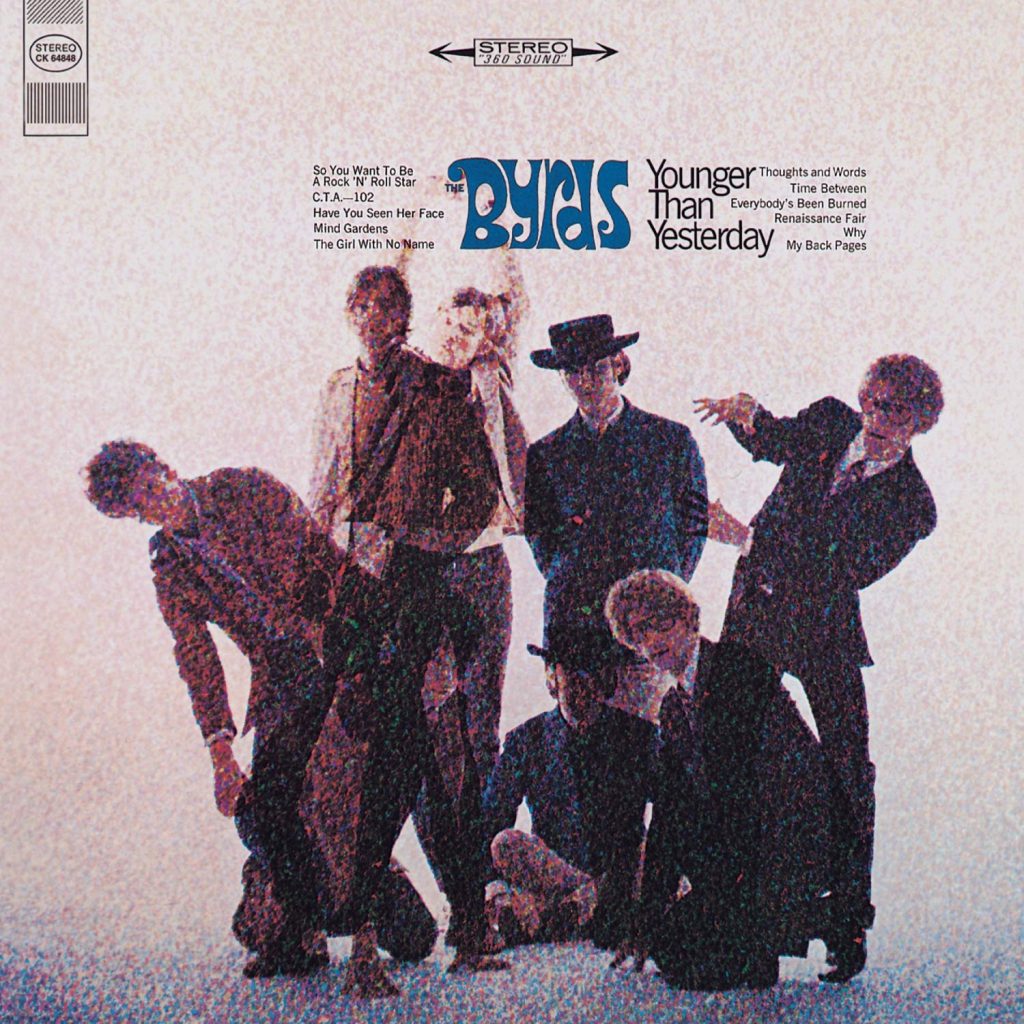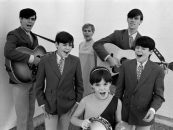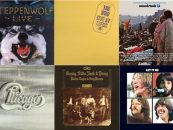The Byrds’ ‘Younger Than Yesterday’—An Ambitious Studio Flight
by Sam Sutherland Released in early February 1967, the fourth Byrds album landed with more of a ripple than a splash in a pool of new music teeming with new faces and bold musical experiments. The band’s significant strides on Younger Than Yesterday were underestimated by pundits and fans preoccupied with next big things in a storied year full of them. The Byrds’ singles and album fortunes had receded from 1965’s apogee when their take on Bob Dylan’s “Mr. Tambourine Man” established a blueprint for folk-rock, followed six months later by their vibrant recasting of folk patriarch Pete Seeger’s “Turn! Turn! Turn!” as the title track of their sophomore long-player. Both songs resonated as anthems that shimmered with Rickenbacker electric 12-string magic and lush choral harmonies, topping the singles charts and earning the approval of the Beatles themselves, who had inspired the erstwhile folkies to plug in three years earlier.
Released in early February 1967, the fourth Byrds album landed with more of a ripple than a splash in a pool of new music teeming with new faces and bold musical experiments. The band’s significant strides on Younger Than Yesterday were underestimated by pundits and fans preoccupied with next big things in a storied year full of them. The Byrds’ singles and album fortunes had receded from 1965’s apogee when their take on Bob Dylan’s “Mr. Tambourine Man” established a blueprint for folk-rock, followed six months later by their vibrant recasting of folk patriarch Pete Seeger’s “Turn! Turn! Turn!” as the title track of their sophomore long-player. Both songs resonated as anthems that shimmered with Rickenbacker electric 12-string magic and lush choral harmonies, topping the singles charts and earning the approval of the Beatles themselves, who had inspired the erstwhile folkies to plug in three years earlier.
Hindsight confirms just how rapidly rock ’n’ roll was transformed over that decade, and how swiftly it metastasized with new stylistic variants. The Byrds had veered from their jingle-jangle signature to break new sonic ground with “Eight Miles High,” bristling with hot-wired electric guitars and muscular electric bass that evoked a melee of psychedelic, free jazz, and Indian influences, placing them in the vanguard of psychedelic rockers alongside the Yardbirds, the Beatles and the Rolling Stones as well as the Bay Area’s lysergic troubadours.
The track served as centerpiece for The Byrds’ third album, Fifth Dimension, which ranged beyond the folk sources of the first two albums with more experimental originals while grappling with a splintered lineup. Gene Clark had left the flock after writing “Eight Miles High” with Jim McGuinn and David Crosby, his comrades in the band’s founding trio, stripping them of their most prolific songwriter. The LP’s experimental thrust only heightened its uneven material, noteworthy for McGuinn and Crosby’s efforts to break new stylistic ground as writers, with “Eight Miles High” handicapped by radio stations wary of presumed drug references.
When the band returned to Columbia’s Sunset Boulevard studios on the Monday after Thanksgiving 1966, they distanced themselves from the earlier mandate to chase single hits. “This time around, we decided it was better to follow the lead of groups like the Beatles ,who weren’t focused solely on hit singles, but on creating great albums that stood as a cohesive creative work,” Chris Hillman would recall in his 2020 memoir, Time Between: My Life as a Byrd, Burrito Brother and Beyond. Until then the shyest Byrd, Hillman had played bluegrass and guitar as a teenager before switching to electric bass when he joined the band, but in the wake of Fifth Dimension’s disappointing reception, Hillman stepped up as a songwriter and singer after moonlighting with David Crosby on demo sessions for Letta Mbulu, a South African vocalist.
The Mbulu sessions were produced by South African trumpeter Hugh Masekela, whom Hillman and Crosby had met through Peter Fonda. Playing alongside crack jazz musicians, “leaving me and Crosby as the two white guys who couldn’t read a note,” was empowering for Hillman, for whom the session “was like an epiphany,” inspiring him to pull out the Gibson J-45 acoustic guitar he’d bought the previous year and begin writing his own songs.
Shortly after those first new pieces, he came up with the opening riff and first verse of a new song directly influenced by playing alongside Masekela and his band. He called Jim McGuinn to come over and hear the seed of “So You Want to Be a Rock ’n’ Roll Star,” and McGuinn quickly fashioned a 12-string guitar arrangement that complemented Hillman’s intricate bass part and added a bridge based on a song by Miriam Makeba, then married to Masekela.
As the first song tracked for the new album, “So You Want to Be a Rock ’n’ Roll Star” leads with a bravura fusion of styles, incorporating Latin and jazz elements punctuated by Masekela’s vivid trumpet excursions, which spur the band’s heady momentum as they offer a wry takedown of the machinations behind an aspiring band’s bid for stardom. A cassette recording of shrieking female fans taped during the Byrds’ first English tour adds an audio verité flourish to the piece, interpreted at the time as a dig at the Monkees, a claim Hillman dismisses.
Hillman’s newfound confidence pushed him to the album’s foreground as its most prolific songwriter, penning five of the set’s 11 tracks, four of them as sole writer, with that first batch of originals noteworthy for stylistic breadth. The LP’s first side follows “…Rock ’n’ Roll Star” with the Beatle-browed “Have You Seen Her Face,” a graceful mid-tempo valentine buoyed by Hillman’s melodic bass line and group vocals cushioning his lead melody, capped by McGuinn’s exciting, mercurial guitar work. Released as a single just one week before Sgt. Pepper would pull focus from virtually every other record extant, the song fared poorly on the charts but survives as not only an album highlight but one of the band’s most satisfying singles.
While those songs proved Hillman was primed to begin writing his own songs, the first piece he wrote after being energized by the Mbulu demos was rooted in his first love. Built from sturdy country influences, “Time Between” offers a protean country-rock shuffle and a winning platform for Hillman’s lead vocal, decorated with sinuous, string-bending Telecaster lines played by Clarence White, the brilliant guitarist who had graduated from skillful acoustic flat-picking with the Kentucky Colonels to shine as a session ace whom Hillman had befriended during his own bluegrass days.
White’s work on Younger Than Yesterday would enhance the country elements that Hillman introduced and McGuinn embraced, later to bloom on the band’s definitive country-rock manifesto, Sweetheart of the Rodeo, leading to McGuinn’s invitation to join the post-Sweetheart lineup. White’s tenure would prove to be among the longest of any Byrd, with his indelible electric style and pedal steel inflections (courtesy of the ”B-Bender” mechanism he developed with Gene Parsons, who took over as the Byrds’ third drummer) complementing McGuinn’s electric 12-string work.
While Hillman earned his stripes as Younger Than Yesterday’s MVP, Crosby pushed a parallel agenda that generated as much friction as approval. Like McGuinn, he was delving further into jazz and psychedelic elements heard on the previous album, plunging beyond conventional melodic structure and lyric discipline on “Mind Gardens,” the album’s most experimental track and its most controversial, not least of all for his bandmates’ reservations about its rhyme-less musings and musical abstractions.
Related: Our Album Rewind of Sweetheart of the Rodeo
If “Mind Gardens” proved a sonic speed bump, Crosby more than compensated with “Everybody’s Been Burned,” a pensive ballad built on an atmospheric harmonic progression, musing on the emotional risks of a love affair. Rightly hailed for its sophistication, the song was written before Crosby joined the band, but the arrangement draws hushed beauty from Crosby’s delicate lead vocals and McGuinn’s restrained electric guitar harmonics.
Jazz and psychedelia also inform “Renaissance Fair,” one of Crosby’s collaborations with McGuinn, inspired by a visit to one of the earliest Southern California Renaissance Pleasure Faires, held in 1966 in the Santa Monica Mountain city of Agoura, where the Faire’s role-playing participants conjured a romantic take on medieval pageantry that the two songwriters cast as a hallucinatory tableau. “I think that maybe I’m dreaming” serves as a recurrent motif knitting the medieval setting with psychedelic awe, borne on Crosby and McGuinn’s neatly interwoven guitars and Hillman’s intricate melodic bass line. The song’s imagery is reminiscent of courtly hippie reveries by Donovan, the Rolling Stones and Led Zeppelin and anticipates Crosby’s subsequent CSN valentine, “Guinnevere.”
With his role as the band’s primary instrumentalist and de facto leader secure, McGuinn indulges his appetite for sci-fi futurism with “C.T.A.-102,” a sequel to “Mr. Spaceman” on Fifth Dimension that ponders whether the real-life quasar of its title is a talisman of extraterrestrial life, embedding a more serious theme under comic sound effects including an electronic oscillator, used to convey the quasar’s electronic signature on radio telescopes, as well as sped-up overdubs of dialogue that stand in for alien voices.
Those studio enhancements provide the most obvious evidence of Revolver’s influence on the album, also audible in the expanded instrumentation and stylistic diversity. The Byrds’ success in harnessing those elements into a coherent package owes much to Gary Usher, who had taken over as producer after the band parted ways with Terry Melcher, who piloted the first two albums, and Allen Stanton, who had left Columbia after producing Fifth Dimension. In Usher, a former surf music artist and songwriting partner with Brian Wilson, the band tapped a seasoned studio veteran who relished experimentation and brought the combination of technical knowledge and studio discipline to shepherd their most adventurous albums. Where Revolver reflected three months of open-ended studio experimentation between the Beatles and producer George Martin, Younger Than Yesterday was completed in 11 days yet covers nearly as varied a musical landscape.
“So You Want to Be a Rock ’n’ Roll Star” did return the Byrds to the top 30, and modest stateside chart success was notched for the seven-inch release of “Have You Seen Her Face,” but a non-album single release for Crosby’s “Lady Friend” fell short. The LP’s other most enduring single was a track Crosby had opposed, dismissing it regressive—another Bob Dylan cover. Croz may have been underwhelmed, but the Byrds’ lissome reading of “My Back Pages” revisited their core style in a meditation on youth and wisdom that would ripen with passing decades as a quintessential Byrds song, chiming with familiar 12-string accents and McGuinn’s graceful lead vocal. A radio edit excising the album track’s second verse would reach the top 30.
Recorded four months after the Beatles unveiled Revolver and released on Feb. 6, 1967, four months before Sergeant Pepper raised the bar on studio innovations further, Younger Than Yesterday would survive its modest commercial success to eventually emerge from the shadows of the Liverpool quartet’s twin classics to be recognized as one of the Byrds’ most fully realized albums. Usher would go on to produce the next two Byrds albums, but the quartet on hand would not survive the completion of the next LP, The Notorious Byrd Brothers. Crosby’s clashes with his bandmates would lead to his expulsion midway through those sessions, with drummer Michael Clarke soon to follow.
[The album, and other Byrds recordings, are available to order in the U.S. here and in the U.K. here.]
Bonus Video: A pantheon of musical luminaries converged on Carnegie Hall on October 16, 1992, to salute Bob Dylan on the 30th anniversary of his debut as a recording artist, where a joyful performance of “My Back Pages” took its cues from the Byrds’ 1967 version rather than Dylan’s solo acoustic original. Roger McGuinn took the first verse, followed by Tom Petty, Neil Young, Eric Clapton, Bob Dylan, George Harrison with Steve Cropper, Duck Dunn, Jim Keltner and G.E. Smith among familiar faces in the backing band.
Bonus Video 2: For heartland fan and rock classicist Tom Petty, the Rolling Stones and the Byrds were dominant genes in his musical DNA, with the latter band’s Rickenbacker sonics woven into the band’s sound. Petty and his crack bandmates saluted their folk-rock heroes with their faithful cover of “So You Want to Be a Rock ‘n’ Roll Star.”








10 Comments so far
Jump into a conversationUnfortunately so low in the the US and UK charts at the time…it did deserved so much a better réception…..!
YOUNGER THAN YESTERDAY reached #24 on Billboard’s best-selling LPs chart, the same as the previous album, FIFTH DIMENSION.
#24 was the highest a Byrds album would reach on that survey until the greatly anticipated BYRDS reunion album of 1973, which made it to #20.
Eight Miles High was largely written by Gene Clark when he was still a Byrd, though David Crosby and Roger McGuinn also got co-writing credits. Gene’s vocals were in the mix with those of David and Roger.
Eight Miles High came out as a single in March 1966, but was also an album track on Younger Than Yesterday when it was released in early ‘67. By that point, Gene was long gone from the band.
“Eight Miles High” was included on the Byrds’ third album, FIFTH DIMENSION, released in July 1966.
It appeared on 5D, not YTY.
I was 16 when this came out and it grabbed my attention and the attention of most of my friends. It was and is a true classic.
When I was in high school in the ‘60’s , the band I was in learned to play My Back Pages. The chords were easy to figure out but the lyrics, well suffice it to say, we faked half of them as we could not decipher them off the 45. Back then we did not have the advantage of the Internet to get the words to songs. Reading the words now, we were so off. Thank God none of the kids listening to us play the song, had any idea either what they were singing. I think Brown Sugar’s lyrics were probably easier to learn..
Thanks for the piece on the Byrds’ YOUNGER THAN YESTERDAY album.
In 1970, I “worked” for the Byrds for one night, unloading their equipment from a truck for a performance at Muhlenberg College in Allentown, Pennsylvania. This allowed me to hang out backstage with the group, where I spent an hour chatting with McGuinn.
We both agreed that YOUNGER THAN YESTERDAY might have been the Byrds’ best album but that “Mind Gardens” was a major bringdown on the album’s second side.
Fifty years later I now dig the Crosby tune but wish they had taken the time to record a few more new tracks so they didn’t have to resort to using the rather limp version of “Why”—especially as the album closer.
That said, I consider YOUNGER THAN YESTERDAY to be one of my faveravest albums ever despite the less-than-stellar second side.
I have the expanded Columbia Legacy CD of Younger Than Yesterday and really love it. The writing, harmonies, and guitar work are all outstanding. All kinds of photos and essays included with the disc.
I heard the Byrds at Meijer amphitheatre about when 5th dimension came out. Crosby was experimenting with that bending note sound from Why. It was all way too cool.